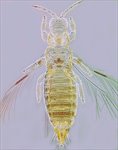Generic diagnosis
Female macropterous or micropterous. Head wider than long with cheeks expanded behind eyes and with transverse ridge; strongly reticulate anterior to transverse ridge; maxillary palps 3-segmented; eyes without pigmented facets; ocellar setae I absent; four pairs of postocular setae. Antennae 8-segmented, segment I without paired dorso-apical setae, III and IV with sense-cones elongate, forked; III–VI annulated, with microtrichial rows on both surfaces. Pronotum wider than long, strongly reticulate in part, with or without one pair of longer posteroangular setae. Mesonotum reticulate; median pair of setae situated far from posterior margin; paired campaniform sensilla present anteromedially. Metanotum with longitudinal reticulation; median pair of setae situated far from anterior margin. Fore wings narrow, veinal setae minute; first vein close to costal vein; posterior fringe cilia wavy. Prosternal ferna weakly connected medially; basantra membranous, without setae. Mesosternum without sternopleural sutures; endofurca without spinula; spinasternum broad and transverse. Metasternum endofurca without spinula. Tarsi 2-segmented; legs reticulate. Tergites without ctenidia; II–VIII each with broad craspedum bearing microtrichia laterally; VIII with S1 setae close to S2; IX with major setae long and stout, two pairs of campanifom sensilla present, MD setae present; X with median split complete, S1 and S2 setae stout. Sternites without craspeda or discal setae; III–VII with three pairs of posteromarginal setae, II with two pairs.
Male similar to female; tergite IX with S1 setae stout, arising from one tubercle, several pairs of tubercles in longitudinal row; tergite X without median split; sternites III–VII each with small pore plate.
Biological data
These are leaf-feeding thrips, of which the most widespread, innoxius, is sometimes a pest on sweet potato, Ipomoea batatas [Convolvulaceae].
Distribution data
Four of the species in this genus are from southeast Asia, with the fifth species from southern Africa.
Nomenclatural data
Dendrothripoides Bagnall, 1923: 624. Type species Dendrothripoides ipomeae Bagnall, 1923, by monotypy.
Two of the five species recognised in this genus (ThripsWiki, 2020) are recorded from China:
innoxius (Karny, 1914: 359). (Euthrips)
poni Kudo, 1977: 497.
Relationship data
Thripidae sub-family Thripinae: this is a diverse group involving more than 230 genera. The most closely related genera to Dendrothripoides are probably two other Asian genera, Indusiothrips and Isunidothrips, although in both of these the fore wings are more robust with more prominent veinal setae. These three genera were at one time considered to be related to the Anaphothrips group (Wilson, 1975), but more recent studies do not support this.
References
Kudo I (1977) The genus Dendrothripoides Bagnall (Thysanoptera, Thripidae). Kontyu 45: 495–500.
Reyes CP (1994) Thysanoptera (Hexapoda) of the Philippine Islands. The Raffles Bulletin of Zoology 42: 107–507.
ThripsWiki (2020) ThripsWiki - providing information on the World's thrips. <http://thrips.info/wiki/Main_Page>
Wilson TH (1975) A monograph of the subfamily Panchaetothripinae (Thysanoptera: Thripidae). Memoirs of the American Entomological Institute 23: 1–354.




